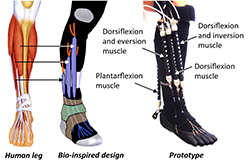A team of researchers have developed an active, soft AFO that mimics the muscles, tendons, and ligaments of the lower leg. They said it could aid in the rehabilitation of patients with ankle-foot disorders such as foot drop, and that this same approach could be used to create rehabilitative devices for other joints of the body or even to create soft exoskeletons that increase the wearer’s strength.

Illustration courtesy of Carnegie Mellon University.
Yong-Lae Park, PhD, an assistant professor of robotics at Carnegie Mellon University (CMU), Pittsburgh, Pennsylvania, worked with collaborators at Harvard University, Cambridge, Massachusetts; the University of Southern California (USC), Los Angeles; Massachusetts Institute of Technology (MIT), Cambridge; and BioSensics, Cambridge, to develop an active orthotic device using soft plastics and composite materials instead of a rigid exoskeleton. The soft materials, combined with pneumatic artificial muscles (PAMs), lightweight sensors, and advanced control software, made it possible for the robotic device to achieve natural motions in the ankle.
The researchers reported on the development in the January 16 issue of the journal Bioinspiration & Biomimetics.
The robotic device would be suitable for aiding people with neuromuscular disorders of the foot and ankle associated with cerebral palsy, amyotrophic lateral sclerosis, multiple sclerosis or stroke, including foot drop and equinus. Active, powered devices can improve function and also help reeducate the neuromuscular system, Park told the Carnegie Mellon News. “But the limitation of a traditional exoskeleton is that it limits the natural degrees of freedom of the body.” The soft orthotic device, by contrast, enabled the researchers to mimic the biological structure of the lower leg. The device’s artificial tendons were attached to four PAMs, which correspond with three muscles in the foreleg and one in the back that control ankle motion. The prototype was capable of generating an ankle range of sagittal motion of 27 degrees (14 degrees dorsiflexion and 13 degrees plantarflexion)-sufficient for a normal walking gait. The tradeoff, however, is that the soft device is more difficult to control than a rigid exoskeleton. It thus required more sophisticated sensing to track the position of the ankle and foot and a more intelligent scheme for controlling foot motion, Park said.
Among the innovations in the device are sensors made of a touch-sensitive artificial skin, thin rubber sheets that contain long microchannels filled with a liquid metal alloy. When these rubber sheets are stretched or pressed, the shapes of the microchannels change, which in turn causes changes in the electrical resistance of the alloy. These sensors were positioned on the top and at the side of the ankle.
Park said additional work will be necessary to improve the wearability of the device. This includes artificial muscles that are less bulky than the commercially produced PAMs used in this project. The device has yet to be tested on patients to determine its performance as a rehabilitative tool.
Editor’s note: This story was adapted from materials provided by Carnegie Mellon University.




